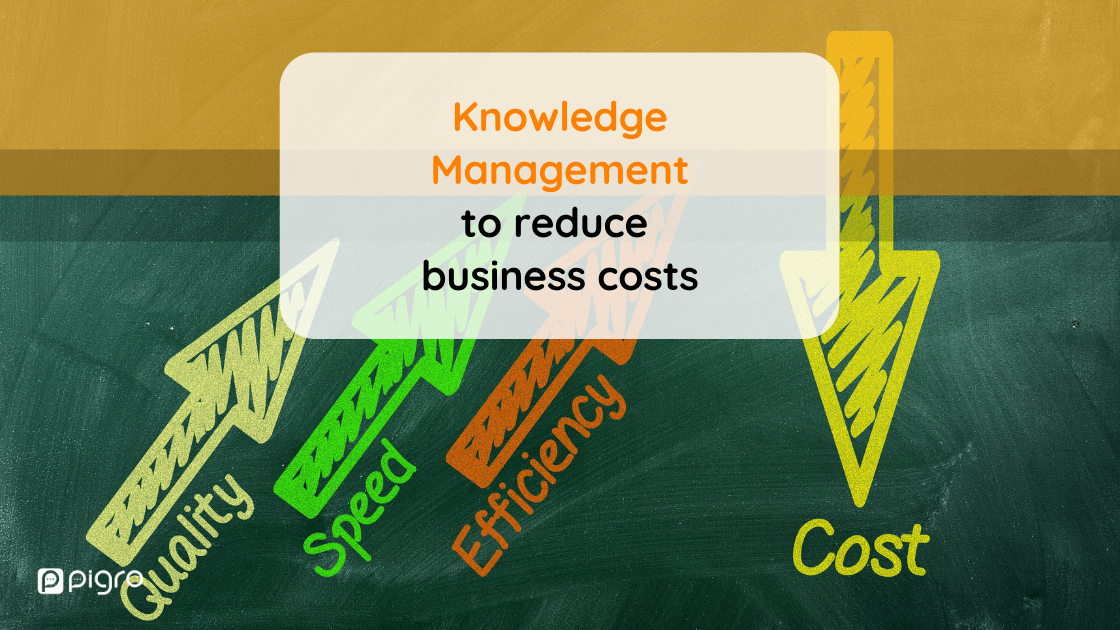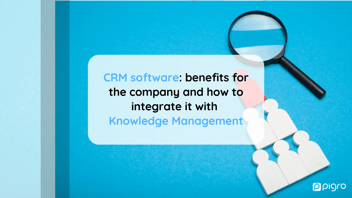Corporate Knowledge Management aims to optimise resources within companies and facilitate access to knowledge. Integrating knowledge management methods into your business strategy can therefore be an advantage in terms of reducing business costs. Let's see how to cut costs in a business.
If you are interested in a Knowledge Management solution, contact a Pigro expert for free for more information. Or, read on to learn more.
Corporate resources management with a Knowledge Management strategy
Business resources (or business assets) can be classified into two main categories: tangible and intangible assets. The first ones include all physics and financial resources that can be revealed in the financial statements, the second ones are not measurable resources, such as production methods, the capacity of innovation and access to information.
Among the intangible resources, we mentioned the information and knowledge that resides in the firm's personnel. Among these are certainly all those best practices that allow new procedures to be addressed and problems to be solved, but which are often not capitalized, and are not collected and organized to be made available to those who need them.
The leakage of valuable information can result in high costs to the business. The costs associated with finding this information and the costs associated with the time to reconstruct the information not found clearly translate into time not spent on profitable activities.
For these reasons, it is necessary that each company or organisation has knowledge management systems. Knowledge Management software, indeed, allow resource optimisation to achieve the goal of business cost reduction.

How to reduce business costs with KM solutions
Enterprise knowledge management (KM) relies on implementing systems to store, manage, and track the information contained in the Knowledge Base.
The use of knowledge management software should guarantee some base advantages that allow for cutting costs in business:
- be compatible with all file formats (desktop and web);
- be integrated with multiple platforms and applications
- make it possible to divide into users and groups concerning access to documents;
- make it possible to follow up and update content, providing graphs and analysis of activities;
- guarantee data security, also on the cloud.
This improves the workflow of the company, avoiding wasted time searching for documents and procedures or opening tickets. Employees will be able to focus on higher value-added activities while promoting collaboration.
In addition, providing access to knowledge also improves relationships with customers, who will no longer have to call Customer Service or wait for an answer, but will be able to receive the information they are looking for promptly or research it themselves.
The costs that are reduced by the introduction of document management software are mainly related to material resources, linked to the creation and storage of physical paper documents.
Thanks to cloud storage, accessing information and retrieving files is easier and possible even remotely.
How to improve business productivity?
Improving business productivity is a crucial goal for any organization. By implementing effective strategies and utilizing the right tools, businesses can streamline their processes, increase efficiency, and ultimately achieve higher levels of productivity. Here are a few key tips to help improve business productivity:
1. Embrace technology: In today's digital age, technology plays a vital role in enhancing productivity. Implementing the right software and tools can automate repetitive tasks, streamline workflows, and improve collaboration among team members. Knowledge management software, such as Pigro, can be a valuable asset in this regard. It allows for easy storage, management, and tracking of information, enabling employees to quickly access the knowledge they need to perform their tasks efficiently.
2. Foster a culture of continuous learning: Encouraging employees to continuously learn and develop their skills is essential for improving productivity. By providing opportunities for training, workshops, and professional development, businesses can empower their workforce to acquire new knowledge and stay up-to-date with the latest industry trends. Knowledge management systems can play a significant role in facilitating this culture of continuous learning by providing a centralized platform for sharing and accessing information.
3. Streamline communication and collaboration: Effective communication and collaboration are vital for smooth workflow and improved productivity. Implementing collaborative tools, such as project management software or communication platforms, can help team members stay connected, share ideas, and work together seamlessly. Knowledge management systems often come with built-in collaboration features, allowing employees to collaborate on documents, share feedback, and contribute to a collective knowledge base.
4. Set clear goals and provide feedback: Clear goals and objectives provide employees with a sense of direction and purpose. When employees understand what is expected of them and how their work contributes to the overall goals of the organization, they are more motivated and focused. Regular feedback and performance evaluations help employees track their progress and identify areas for improvement, ultimately leading to increased productivity.
5. Encourage work-life balance: Maintaining a healthy work-life balance is crucial for employee well-being and productivity. When employees are stressed or burned out, their performance and productivity suffer. Encouraging flexible working hours, promoting self-care practices, and providing a supportive work environment can help employees maintain a healthy work-life balance, leading to improved productivity.
By implementing these strategies and utilizing knowledge management solutions like Pigro, businesses can significantly enhance their productivity levels. Remember, improving productivity is an ongoing process that requires continuous evaluation, adaptation, and investment in the right resources and tools.
How to improve efficiency in a business focusing on people: 3 benefits of enterprise resources optimization
Knowledge Management was developed with the goal of managing corporate knowledge, both explicit and implicit.
Therefore, this branch of business focuses not merely on explicit and documented knowledge, but also on people. All those who, being part of an organization, constitute its most important capital, holders of know-how and experience, represent the so-called “tacit knowledge”.
Focusing on the development of a good Knowledge Management system today means creating opportunities for all employees and customers of a company to share and have access to information, as quickly and easily as possible, thus reducing costs and resources to be used in the business workflow.
Creating an on-cloud database, which can be accessed anytime, anywhere, ensures knowledge circulation for all departments. But before adopting a KM system, it is a good idea to highlight (and implement) a few tips related to your organization's culture.
-
Among these is the good practice of identifying and valuing the experts you have in your firm.
If an employee is rewarded for being an expert on a particular topic, they will be more likely to share their knowledge and experience.
-
To do this, it is also necessary to spread the practice of documenting best practices for problem-solving.
In this way, each employee will be accustomed to annotating the steps when dealing with a new problem-solving procedure, which will form a new knowledge base.
-
Finally, all that remains is to encourage collaboration between people. How? By providing employees and collaborators with social tools to connect and work as a team.
These expedients will be useful to bring out the tacit knowledge, and exchange tips and information based on the skills of each, to foster the culture of Knowledge Sharing.
Read also How to increase business productivity while reducing waste with KMS.
Want to know more on Knowledge Management? Contact a Pigro expert!



